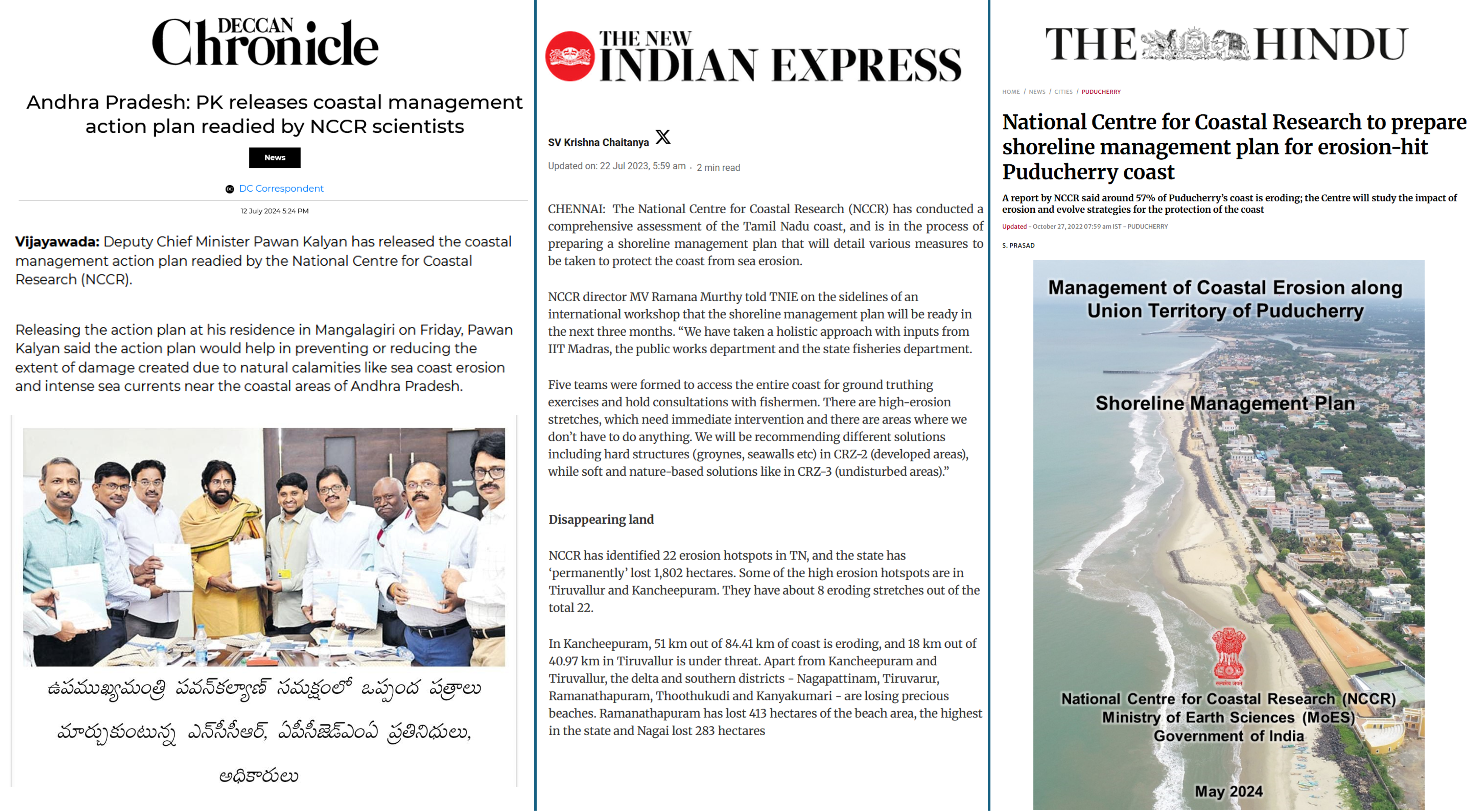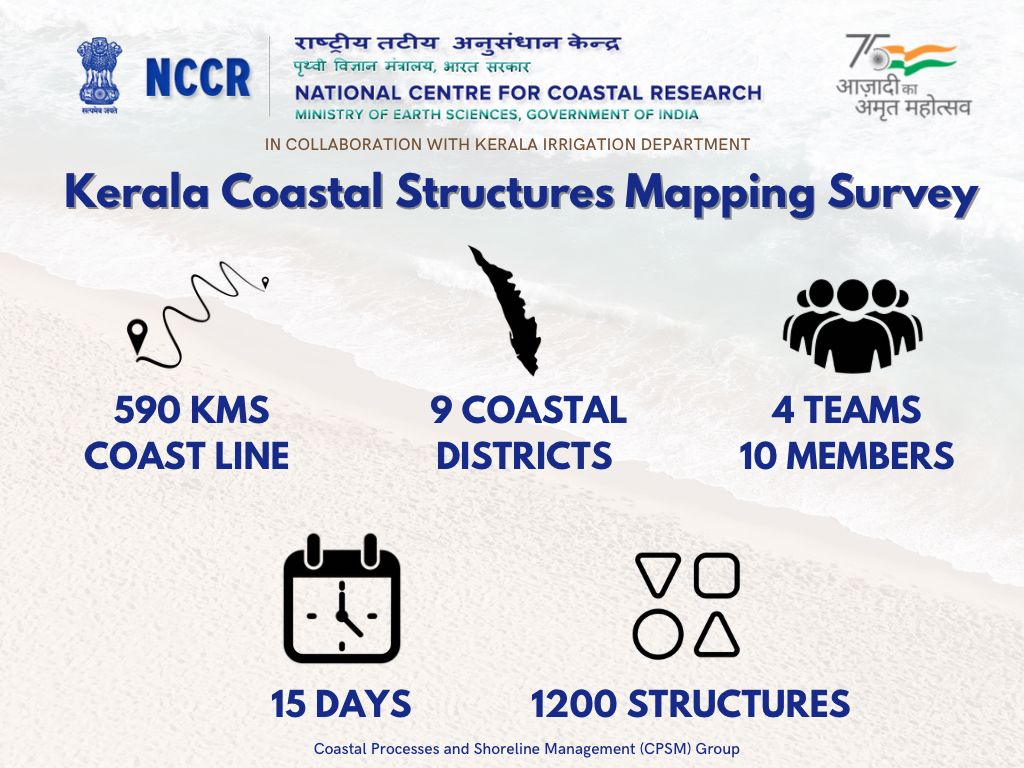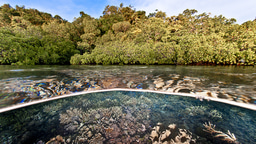Mapping Kerala's Coastal Defences: From Field Survey to Shoreline Management Plans
Published in Earth & Environment and Civil Engineering
Coasts are among the most dynamic and vulnerable environments on our planet. In Kerala, India's southwestern coastal state, reports revealed that 41% of the shoreline is eroding, threatening communities, livelihoods, and infrastructure. In response, the Government of Kerala has invested heavily in coastal protection; today, nearly half of the coastline is armoured with structures such as seawalls and groynes.
Yet, despite this scale of intervention, a fundamental question remained unanswered: How well are these structures actually performing?
A statewide survey begins
In August 2022, our team of 10 scientists from the National Centre for Coastal Research (NCCR), divided into 4 groups, set out to answer this question. Over 15 days, we travelled the entire 593 km Kerala coastline, spanning 9 districts, and systematically mapped and evaluated 331 km of seawalls and 459 gryones.
The survey, conducted in collaboration with the Kerala Irrigation Department (KID), was not limited to documenting structures alone. We also recorded geomorphological features, sediment conditions, and functional performance indicators, providing a unique, state-scale perspective on coastal protection.
From survey to science
The insights from this unprecedented field campaign formed the basis of our recent publication in the Journal of Coastal Conservation.
“Statewide Field Assessment of Coastal Protection Structures in Kerala, India: Structural and Functional Insights.”
Our study showed that while coastal protection structures provide localised protection, many were in varying stages of disrepair, and their functional performance often depended on seasonal conditions, such as the erosive impact of the southwest monsoon. Importantly, our evaluation also highlighted zones where multiple defence types overlapped, revealing both opportunities and challenges in integrated management.
Policy impact: Kerala's first Shoreline Management Plan
Beyond research, this work directly informed practice. Using the field dataset and analysis, Kerala's first Shoreline Management Plan (SMP) was developed by NCCR in partnership with the state government. The SMP provides evidence-based guidance for future interventions, balancing protection needs with geomorphological realities.
Scaling out: Andhra Pradesh, Tamil Nadu, Puducherry
The Kerala survey was not an end but a beginning. The methods developed during this pilot - standardised field protocols, performance evaluation frameworks, and integration of geomorphology with engineering - were later extended to Andhra Pradesh, Tamil Nadu, and Puducherry, supporting the preparation of their SMPs as well. This demonstrates how a state-level field study can scale into a national framework for coastal resilience.

If you are interested in what these documents look like, you can check out the Puducherry SMP document available officially from their website at this link: https://dste.py.gov.in/ppcc/pdf/publichearing/czmp-2019/Draft_SMP.pdf
Looking ahead
As climate change intensifies coastal hazards, adaptive and hybrid approaches will be essential, combining hard protection with nature-based solutions and dynamic shoreline management. This research is one step toward that future, showing how rigorous field science can bridge the gap between local observations and state-wide planning.
For us researchers, the project was not only about structures and coastlines, but also about collaboration between scientists, government departments, and coastal communities. The lessons learned in Kerala continue to guide our work, with the hope of building resilient coasts for the generations to come.
Follow the Topic
-
Journal of Coastal Conservation

The Journal of Coastal Conservation [JCCO] publishes theoretical and applied research on integrated and sustainable management of the terrestrial, coastal and marine environmental interface.
Related Collections
With Collections, you can get published faster and increase your visibility.
Sustaining Life Below Water: Conserving, managing, and protecting our marine and freshwater resources
Plastic waste, overfishing, ocean acidification, increasing eutrophication are some of the major threats endangering our oceans, rivers and lakes. With this collection we aim to create a cross-disciplinary home for research articles, perspectives, and emerging topics addressing the conservation and sustainability of the use of our marine and freshwater resources. By putting scholarship supporting this UN Goal in the spotlight we hope to increase the scientific knowledge and awareness of the targets and indicators set by the UN Goal such as reducing marine pollution, strengthening resilience, restoring coastal ecosystems, minimizing the impacts of ocean acidification, reducing destructive fishing practices, providing access for small-scale fishers to marine resources and markets and more.
We call for submissions on (but not limited to) the following topics:
•Biotelemetry and bio-logging
•Dam removal policy and development
•Economic benefits to Small Island developing States and least developed countries through sustainable management of fisheries, aquaculture and tourism
•Effects of reef degradation on ecosystem goods and services
•Environmental DNA and RNA
•Environmental flows
•Fish migration and passage
•Fisheries-induced evolution
•Floodplain management
•Hydropower mitigation
•Links between reef health and human health
•Methods and case studies and their scientific assessment, to manage, protect, and restore wetlands, to prevent and significantly reduce wetland pollution, in particular from land-based activities, including sedimentation from poor land-use, plastic and nutrient pollution
•Physiology and health of wild fish
•Preventing and reducing (plastic) pollution/waste in particular from land-based activities, including marine debris and nutrient pollution
•Policy development in river and lake management
•Reducing/minimizing ocean acidification
•Regulating harvesting, ending of overfishing and destructive fishing practices, and science-based management plans to restore fish stocks
•Restoration goals in lake management River and lake restoration
•Strengthening resilience and restoration of coastal ecosystem Understanding and improving sustainable use of coral reef resources.
How to submit? Please use the Submit to this journal link from the participating journals. These journals can be viewed in the right menu. During submission you will be asked if you would like your article to be included in a Topical Collection. Select ‘Yes’ and select the name of this collection from the drop down menu: TC: Sustaining Life Below WaterSubmissions to the collection may be original research articles, perspectives or review articles. Please read the submission guidelines for each journal before submitting. Each submission will undergo thorough and rigorous peer review according to each journal’s peer review editorial policy. Accepted articles will be published in their respective journal and will benefit from being cross-linked as well on the collection page.
The following journals are participating in this collection:•Aquatic Ecology
•Aquaculture International
•Aquatic Sciences
•Coral Reefs
•Environmental Biology of Fishes
•Estuaries and Coasts
•Fish Physiology and Biochemistry
•Fisheries Science
•Hydrobiologia
•Journal of Applied Phycology
•Journal of Coastal Conservation
•Journal of Ocean University China
•Limnology
•Marine Biology
•Marine Biotechnology
•Maritime Studies
•Ocean Science Journal
•Reviews in Fish Biology and Fisheries
•Thalassas: An International Journal of Marine Sciences
•Wetlands Ecology and Management
Publishing Model: Hybrid
Deadline: Ongoing
New Trajectories in Coastal Conservation: Building Resiliency along the Pacific Americas Flyway
Publishing Model: Hybrid
Deadline: Ongoing






Please sign in or register for FREE
If you are a registered user on Research Communities by Springer Nature, please sign in